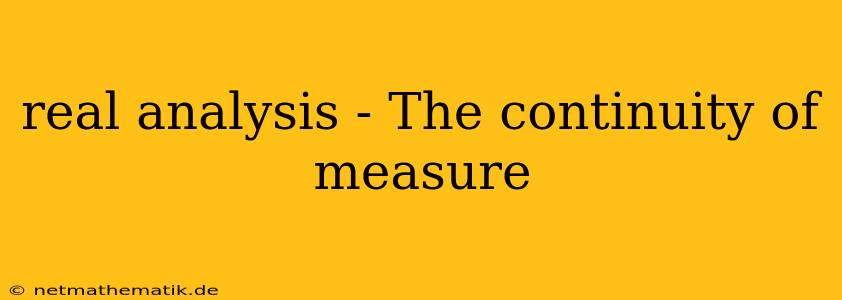The continuity of measure is a fundamental concept in real analysis, particularly in the study of measure theory. It describes the behavior of a measure with respect to sequences of sets. This concept plays a crucial role in proving many important theorems in measure theory and probability theory. Intuitively, it states that if a sequence of sets converges to a limit set, then the measure of the sequence should converge to the measure of the limit set. This principle allows us to work with limits of sets, which are often difficult to define directly, by approximating them with sequences of simpler sets.
Continuity from Below
The first type of continuity is called continuity from below. This concept deals with increasing sequences of sets.
Definition: Let $(X, \mathcal{A}, \mu)$ be a measure space. A measure $\mu$ is continuous from below if for any increasing sequence of sets ${E_n}{n=1}^\infty$ in $\mathcal{A}$ such that $E_n \subset E{n+1}$ for all $n$, and $E = \bigcup_{n=1}^\infty E_n$, we have:
$\mu(E) = \lim_{n \to \infty} \mu(E_n)$
In other words, the measure of the union of the increasing sequence of sets is equal to the limit of the measures of the individual sets in the sequence.
Example: Consider the Lebesgue measure on the real line, denoted by $\lambda$. Let $E_n = [0, 1 - \frac{1}{n}]$. This sequence is increasing, and its union is $[0, 1)$. We have:
$\lambda(E_n) = 1 - \frac{1}{n}$
and
$\lambda([0, 1)) = 1$
Since $\lim_{n \to \infty} \lambda(E_n) = 1$, the Lebesgue measure is continuous from below.
Continuity from Above
The second type of continuity is called continuity from above. This concept deals with decreasing sequences of sets.
Definition: Let $(X, \mathcal{A}, \mu)$ be a measure space. A measure $\mu$ is continuous from above if for any decreasing sequence of sets ${E_n}{n=1}^\infty$ in $\mathcal{A}$ such that $E_n \supset E{n+1}$ for all $n$, and $E = \bigcap_{n=1}^\infty E_n$, and $\mu(E_1) < \infty$, we have:
$\mu(E) = \lim_{n \to \infty} \mu(E_n)$
The requirement $\mu(E_1) < \infty$ is essential, as without it the continuity from above may not hold.
Example: Consider the Lebesgue measure on the real line, denoted by $\lambda$. Let $E_n = [0, \frac{1}{n}]$. This sequence is decreasing, and its intersection is the empty set, denoted by $\emptyset$. We have:
$\lambda(E_n) = \frac{1}{n}$
and
$\lambda(\emptyset) = 0$
Since $\lim_{n \to \infty} \lambda(E_n) = 0$, the Lebesgue measure is continuous from above.
Relationship Between Continuity from Below and Above
A measure $\mu$ is continuous from below if and only if it is continuous from above for all sequences of sets ${E_n}_{n=1}^\infty$ in $\mathcal{A}$ such that $\mu(E_1) < \infty$. This means that if a measure is continuous from below, it is also continuous from above, and vice-versa, provided that the initial set has finite measure.
Importance of the Continuity of Measure
The continuity of measure is a crucial property in measure theory and has numerous applications, including:
1. Defining Measures on More General Sets
The continuity of measure allows us to define measures on more general sets by approximating them with sequences of simpler sets. For example, we can define the Lebesgue measure on the Borel sets by approximating them with sequences of open sets or closed sets.
2. Proving Key Theorems in Measure Theory
The continuity of measure is essential for proving many important theorems in measure theory, such as:
- The Monotone Convergence Theorem: This theorem states that the limit of an increasing sequence of non-negative measurable functions is measurable and its integral is equal to the limit of the integrals of the functions in the sequence.
- The Dominated Convergence Theorem: This theorem states that if a sequence of measurable functions converges pointwise to a measurable function and is dominated by an integrable function, then the limit of the integrals of the functions in the sequence is equal to the integral of the limit function.
- The Lebesgue Differentiation Theorem: This theorem states that for a function $f$ that is Lebesgue integrable on $\mathbb{R}^n$, its derivative exists almost everywhere and is equal to its average value over small balls centered at the point.
3. Applications in Probability Theory
The continuity of measure also plays a crucial role in probability theory. It is essential for proving the following important theorems:
- The Law of Large Numbers: This theorem states that the average of a sequence of independent and identically distributed random variables converges to the expected value of the random variable.
- The Central Limit Theorem: This theorem states that the sum of a large number of independent and identically distributed random variables, when properly normalized, converges to a normal distribution.
Conclusion
The continuity of measure is a fundamental concept in real analysis with significant implications in both measure theory and probability theory. Its importance stems from its ability to handle limits of sets and functions, which allows for the development and proof of powerful theorems and the study of various phenomena in probability and other fields. Understanding this concept is essential for a deeper understanding of measure theory and its applications.
